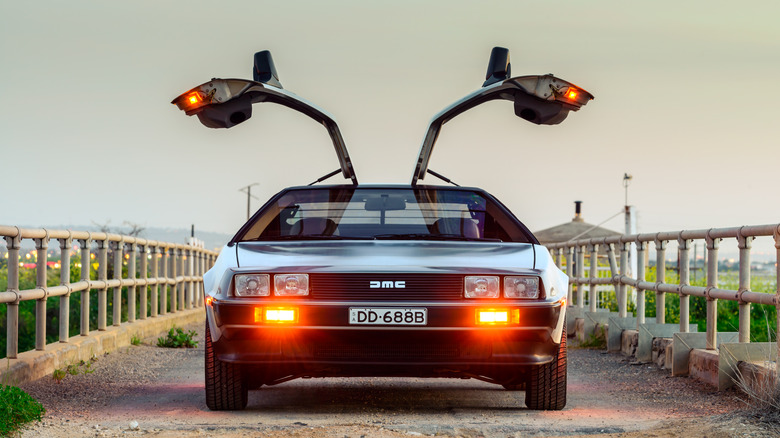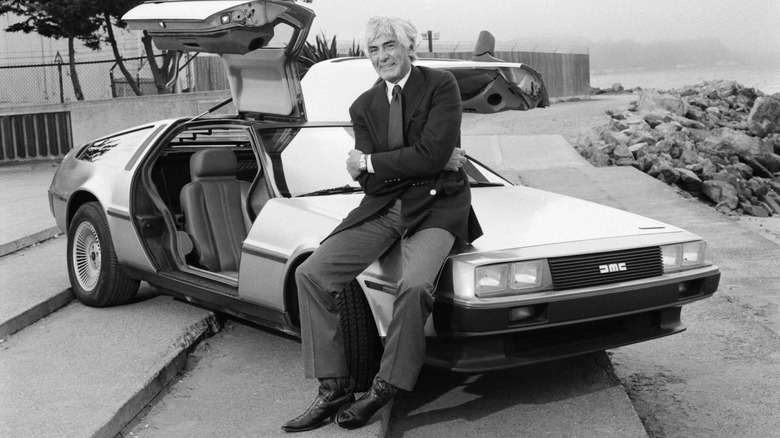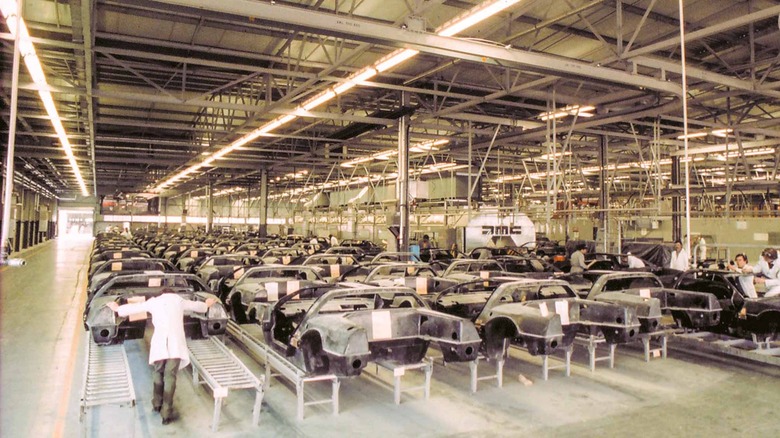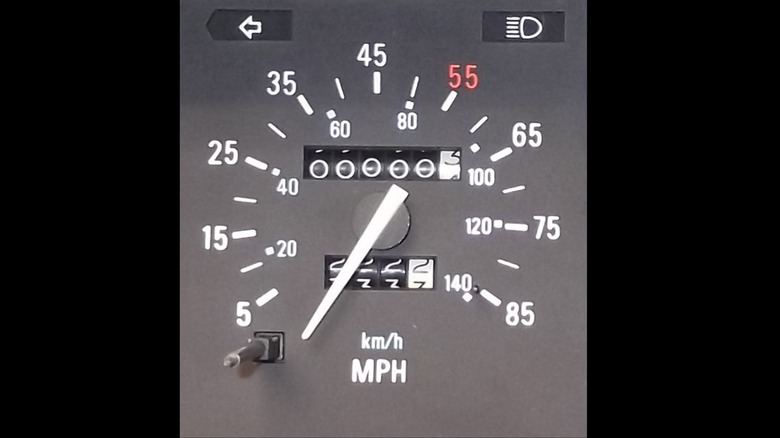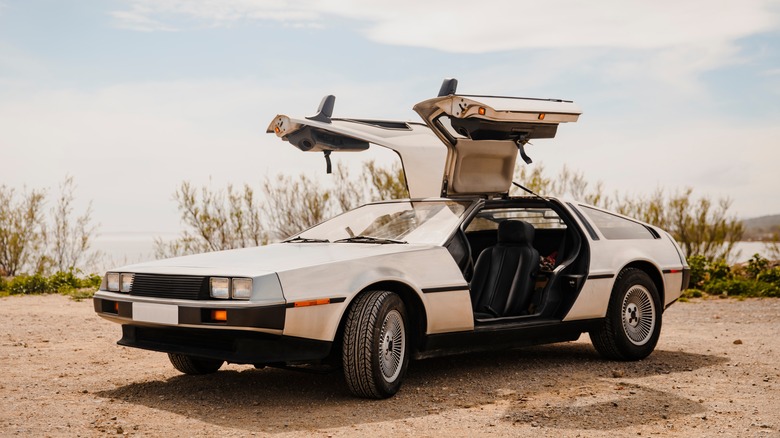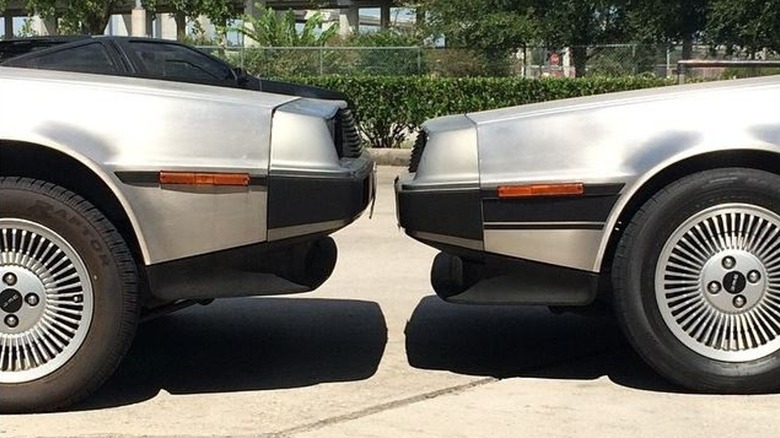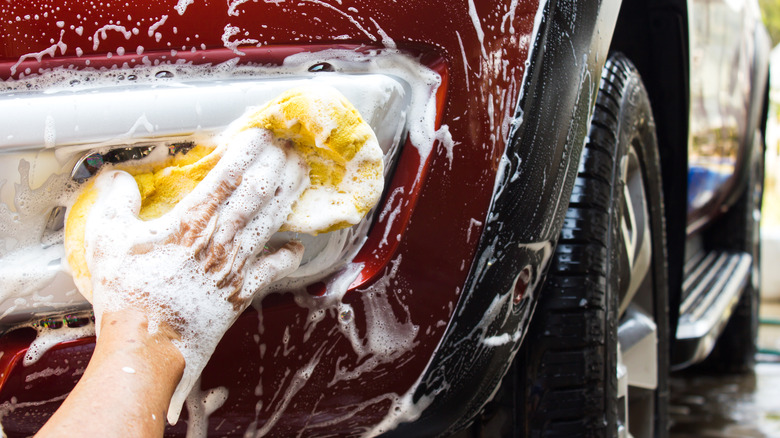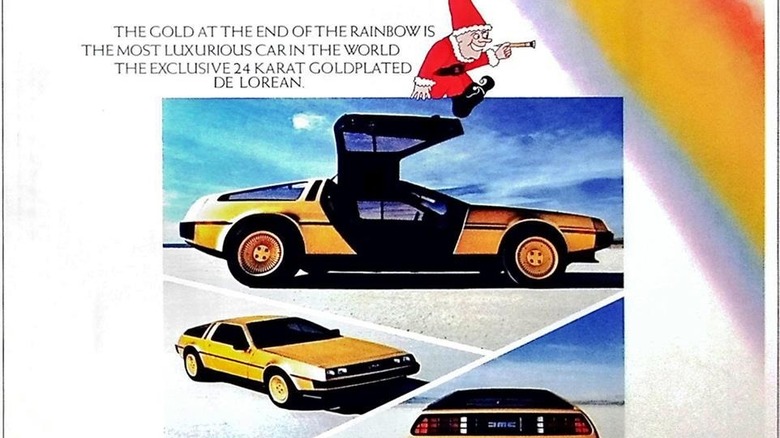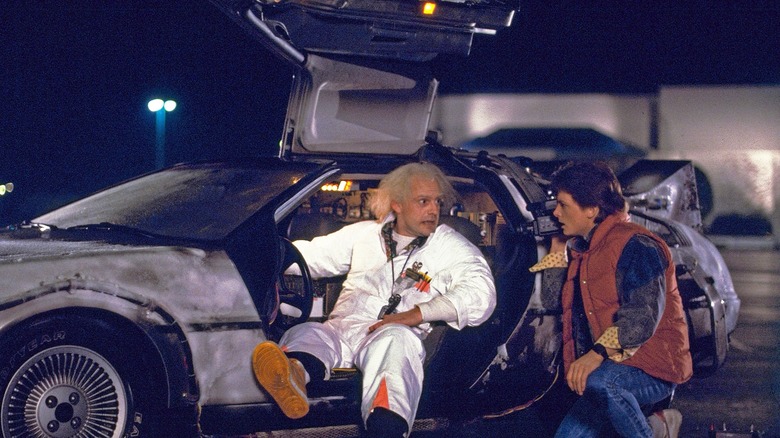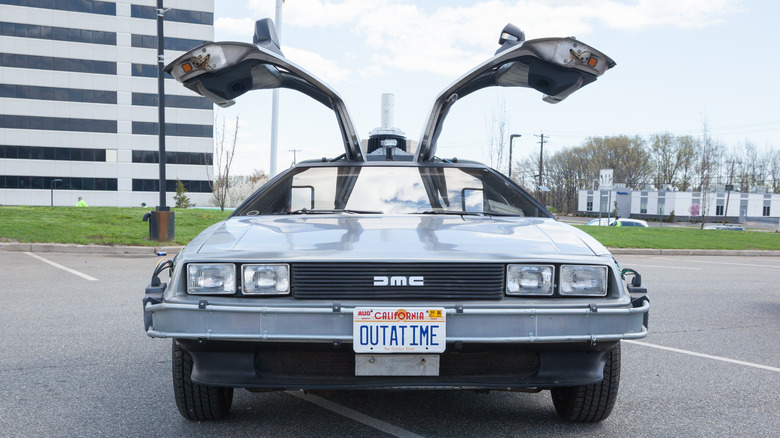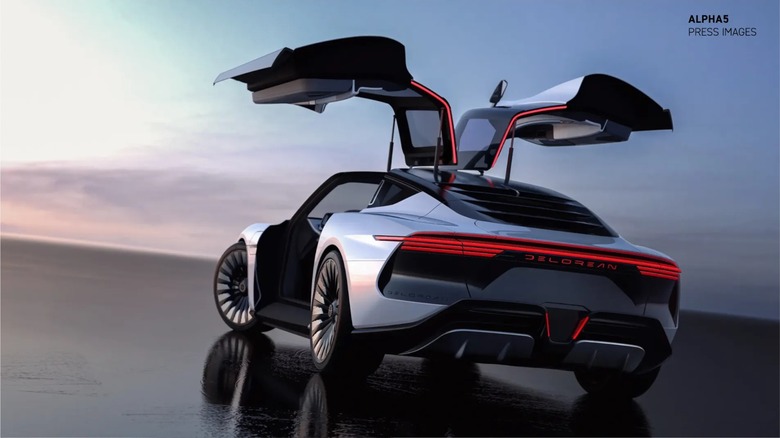11 Facts About Back To The Future's Iconic 1981 DeLorean DMC-12
With its gull-wing doors and blockbuster bona fides, the DeLorean is one of the most recognizable cars to ever hit the road. It's most famous for its role as a four-wheeled time machine in Robert Zemeckis' science fiction classic "Back to the Future" trilogy.
Here in the real world, the DeLorean's story was all too brief, bizarre, and surrounded by a story worthy of its own blockbuster movie. Its creator, John DeLorean, had a long and storied history in the automotive industry. Throughout his career, he was instrumental in the development of several well-known vehicles including the Pontiac GTO, Pontiac Firebird, and the Pontiac Grand Prix, before leaving Pontiac to start his own company.
DeLorean spent several years building a company, designing what would be that company's only car, and figuring out the manufacturing process. Finally the DeLorean, known internally as the DMC-12, hit the asphalt and zoomed into our collective hearts and minds at 88 miles per hour. Of course, the DeLorean is more than just the most recognizable time machine of all time. Here are the top facts about the famed but ill-fated DeLorean DMC-12
It was designed by Giorgetto Giugiaro
The DeLorean succeeded in capturing the imagination of the public, even while it failed financially, in large part because of its unique design. That design came courtesy of Giorgetto Giugiaro, a renowned Italian automotive designer. While the DeLorean is one of his most memorable designs, it's far from the only one.
Giugiaro also designed the Lotus Esprit and the Volkswagen Golf, among dozens of others. Giugiaro was named Car Designer of the Century (an achievement which has only been awarded once), in 1999. He was selected by the Global Automotive Elections Foundation and inducted into the Automotive Hall of Fame in 2002. While he's most well-known for designing cars, he's also lent his talents to the design of camera bodies, cathedral organs, and a shape of pasta.
In the early '80s the DeLorean's design conjured images of an exciting new future just around the corner. It's no wonder that it was chosen as the shell for Doc Brown's famous time machine. Unfortunately, the DeLorean didn't live up to its overhyped promises.
The DeLorean was only produced for two years
John DeLorean had hoped to make his namesake vehicle at General Motors, but the company declined and DeLorean struck out on his own, founding the DeLorean Motor Company in 1975. The first DeLorean rolled off the factory floor in 1981, just two years later it was dead.
He searched around the world for the most economical manufacturing opportunity and eventually settled in Northern Ireland. The price was right but the workforce was inexperienced, and that would come back to bite DeLorean in the long run. A factory was built with the express purpose of pumping out DeLoreans to the tune of 30,000 per year, but those numbers were never realized.
Over the course of two years fewer than 10,000 DeLoreans were produced, 6,500 of which still exist. Moreover, the car came in at more than twice the $12,000 intended price tag. Taken together, the company was producing fewer cars than planned and they weren't selling as hotly as expected. DeLorean's days were numbered.
Its speedometer capped out at 85 mph (but it went faster)
These days, modern cars typically come with digital displays that show your speed or how much fuel you have in real time. Not so long ago, however, dashboard displays were largely physical, relying on needles which pointed at your speed or fuel level. Because they were physical, it was possible to create a gauge which didn't necessarily give an accurate picture. That was the case with the DeLorean and pretty much every other car produced at that time.
To find out why, we have to go back in time to 1974 and the passage of the Emergency Highway Energy Conservation Act, which set a national speed limit of 55 miles per hour. Five years later, the National Highway Traffic Safety Administration enacted a regulation which required that all speedometers show a maximum speed of 85 mph. Most speedometers from the time also emphasized the 55 mph limit by making those digits larger or a different color. The regulation didn't last long, but most car manufacturers stuck with the dashboard design for years.
In "Back to the Future," the DeLorean famously had to reach 88 miles per hour to travel in time. It was possible for the DeLorean to reach that speed, but its native speedometer couldn't show it. Filmmakers had to modify the speedometer to illustrate its chronology twisting velocity on screen.
The DeLorean was a disappointing sports car
By all accounts, the DeLorean was a perfectly fine car for driving around town, but it wasn't exactly the sports car it was planned to be. Car and Driver's review of the DeLorean from the time of its release described it as a fun car to drive, but one which had less power and slower acceleration that you would want or expect from a performance vehicle.
Most of that stemmed from the distance between John DeLorean's original vision and what actually rolled off the factory floor. The car that would go on to star in "Back to the Future" looked superficially like the original prototype, but there were significant changes under the hood between the 1976 plan and the 1981 actuality.
Engine placement was changed and the frame had to be retooled, necessitating a change in design and materials. The result was a car that weighed a lot more than intended, coupled with a relatively low-powered 2.9-liter V6 engine. During typical day-to-day driving, the DeLorean generally handled well and offered a smooth ride, but it was a pale shadow of the high-end muscle car it was supposed to be.
Its body is paint-free stainless steel
A vehicle's exterior sets the tone and makes a first impression. You can usually tell something about the car, but also about its driver, just by looking at its exterior. That's why car manufacturers usually offer cars in a variety of colors and trims. While every car of a particular model will be more or less the same, you have an opportunity to customize the look and feel before you drive it home. Not so with the DeLorean.
The body of a car can be made from a variety of materials including metals, fiberglass, carbon fiber, and plastics, just to name a few. Regardless of the material they are usually finished, primed, and painted. The DeLorean Motor Company took a different approach by finishing the DMC-12 with brushed stainless steel panels.
In contrast to most other cars on the road, and with a few exceptions, every single DeLorean looked exactly the same. Moreover, the brushed panels showed every mark and blemish, even fingerprints. Still, the stainless steel panels had a few things going for them. They were made of 304 grade stainless steel, the same stuff commonly used in commercial kitchens. It's the most common form of stainless steel, composed of iron, chromium, and nickel. It's favored because it's easy to form into various shapes, it's resistant to corrosion, and it's non-magnetic. And if you did get a minor scratch or scrape, you could just brush it out.
It could be cleaned with gasoline
In 2021, a TikTok video made the rounds online, ostensibly showing a woman happily washing her car with gasoline from the pump. A closer look reveals what is likely just a water hose with a false "gas pump" attached to the end. But if we were to travel back to 1981, we might actually find some DeLorean owners spot-cleaning their cars with gas.
While using gasoline as a cleaning agent isn't recommended, what with the danger of fire or explosion, people have been using it as a degreaser for decades. Because gasoline is made of hydrocarbons, it's really good at dissolving other hydrocarbons, like engine oil. If you have grease stains on your car after an evening of maintenance, gasoline is pretty effective at getting it off, while being potentially deadly.
Still, the DeLorean's unusual exterior material meant that it more readily accepted unconventional cleaning tactics. The DeLorean owner's manual states, "wash panels with warm water and low suds detergent. Stains of tar or grease may be removed with gasoline or white mineral spirits." If you' own a DeLorean yourself, we recommend sticking with soap, water, and mineral spirits if you've got 'em.
There was a gold version of the DeLorean
There was plenty of hype for the DeLorean even before anyone had a chance to drive one. In 1980, the year before the first DeLoreans would arrive, American Express and DeLorean announced a collaboration, offering a gold-plated car to a select few consumers. For $85,000 (about $325,000 in 2024) American Express members could commission their very own shimmering DeLorean.
The collaboration graced the cover of the 1980 American Express Christmas catalog. The accompanying interior text stated, in part, "the entire corrosion-free stainless steel outer body panels of this limited edition DeLorean will be electroplated with pure 24 karat gold," it further stated that no more than 100 would ever be produced, manufactured in Northern Ireland, and delivered to your choice of any DeLorean dealership in the United States by June of 1981.
The purchase required a deposit of $10,000 toward the $85,000 total price, and American Express made sure to remind everyone that the purchase could be charged to your credit card. Only three gold-plated DeLoreans were ever produced, two for buyers and a third which was maintained for use as spare parts. An additional two DeLoreans were later gold-plated privately by their owners.
Founder John DeLorean got arrested in a drug sting
John DeLorean was a known entity in the automotive industry who had delivered successful cars in the past. In the lead up to the DeLorean's debut, everyone expected this to be another hit including, it seems, John DeLorean himself. People close to him later stated that DeLorean was spending as though the car was already a huge success and that spending continued even after it became clear that wouldn't be the case.
As 1982 was coming to a close, it became clear that the company was in trouble and DeLorean got swept up in an unconventional and highly illegal plan to save it. The company needed $17 million to right the ship and DeLorean spent most of the year trying to find new investors. That's when one of those potential investors, James Hoffman, approached DeLorean with an opportunity.
The details of the deal were vague at first, followed by subtle mentions of Colombian investors. Before long, DeLorean was in a hotel room about to wrap up a multi-million-dollar drug deal. Then the FBI walked in. On October 19, 1982, John DeLorean was arrested and charged in a $24 million drug bust involving 55 pounds of cocaine. During the trial, however, it became clear that DeLorean didn't want to be involved, made it clear he didn't want to be involved, and only cooperated under duress. A jury concluded DeLorean had been entrapped and he was acquitted of the charges.
The DeLorean's afterlife at the movies
Today, most people know the DeLorean as a movie prop from one of the most beloved time travel flicks in history. While the first "Back the Future" film came out just four years after the DeLorean's debut, the company and the car had already been dead for two years.
Doc Brown's modified DeLorean was capable of traveling through time courtesy of its flux capacitor, provided you had enough runway to reach 88 miles per hour and 1.21 gigawatts of energy. That energy could be provided by a tiny nuclear fission reactor and a hunk of plutonium, a Mr. Fusion and some common trash, or a bolt of lightning in a pinch.
The time machine wasn't always going to be a DeLorean. It wasn't even always going to be a car. In the movie's earliest version, the time machine was a stationary laser-based device. Later, it was made slightly more mobile when it was attached to a refrigerator. That design would have made it a spiritual sibling to other boxy time machines like the Doctor's blue police box or Bill and Ted's phone booth. Steven Spielberg was concerned that kids might climb inside real-world refrigerators trying to recreate the events of the movie and the production pivoted to a modified DeLorean instead.
You can buy a DeLorean for yourself
The DeLorean Motor Company filed for bankruptcy in 1982 and it might have faded into obscurity as an unusual chapter in automotive history if not for "Back to the Future." Instead, interest in the car has remained steady even decades later. Someone was bound to see the opportunity sooner or later.
More than a decade after the original company went bust, parts of it were purchased and resurrected. Sort of. A U.S.-based company, headquartered in Texas, purchased the remaining DeLorean parts inventory and set up shop in 1995 selling all things DeLorean.
That sale did not include the DeLorean name or the DMC logo, but the U.S. company used them anyway, reasoning that the original company wasn't using them anymore. In 2014, the company was sued by John DeLorean's widow, Sally Baldwin. They settled out of court for an undisclosed sum and the new company retained the rights to use those assets. That means that today you can buy DeLorean merchandise from the DeLorean Motor Company in addition to service, parts, and DeLoreans in various levels of restoration.
The DeLorean keeps almost coming back
At times, it seems almost as if the universe doesn't want the DeLorean to exist. John DeLorean wanted to return the car to the market for the remainder of his life and he's not alone in that desire. Over the last several years, there have been a handful of announcements suggesting that the Delorean would soon return to the road in some form or another.
In 2016, the DeLorean Motor Company announced it would begin production of new replicas, but that plan never materialized. More recently, the company announced its intention to produce an updated and fully electric version of the DeLorean known as the Alpha5. According to images released by the company, the Alpha5 keeps some of the qualities fans love about the DMC-12, while abandoning others. It has the gull wing doors and the louvered back window, but much of the original car's charm is lost in the new design.
Fans of the classic DeLorean might be more satisfied with the updated offering from DeLorean Next Generation Motors (DNG Motors) and Kat DeLorean, daughter of John DeLorean. It's called the Model-JZD, in honor of John Z. DeLorean. Whether any of these DeLoreans will ever actually make it to market... only the future will tell.
